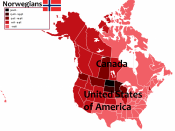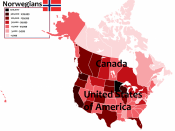Violence in Canadian and American Television Together Americans and Canadians fight against the amount of violence depicted on television. It is unfortunately a growing concern for both countries. More violence is portrayed on American programs; consequently, those programs are the ones that make it on to Canadian television. Evidently it is not just a concern for one country instead an equal concern for both. Violence can be defined as the explicit act of force destined to injure or kill, or the expression of any serious threat to injure or kill a character, whether human or humanlike. This definition of violence is readily seen on television, on a variety of programs such as situational comedy, drama series, cartoons, children's shows, crime shows and sketch comedy. The comparison of Canadian and American violence illustrates that they both have the same affects on viewers; however, the results of criminal activity are a lot higher in the U.S.
The resulting acts of violence coincide with the different laws pertaining to gun control in both countries. The comparison of violence on American and Canadian television has many similarities such as the implementation of the V-Chip, and the effects of watching violence. However, the differences between the countries are apparent when it comes to gun control and the laws that apply.
Canadian and American programs are very unalike. The way they depict issues is entirely different, Canada seems to be much more conservative where as the U.S is more daring. Regardless of whether Canadian programs are different, Canadians still are highly exposed to American television. Evidently there are much more American networks than Canadian, possibly because of their higher population. The amount of violence in U.S programs is 23.4 % more than on Canadian programs (fraserinstitute.ca). It can be implied that the majority of the viewers actually enjoy watching violent programs, since the ratings on violent shows remain high. For instance in American sketch comedy violence seems to be portrayed as a joke, and the issue is not taken very seriously. Subsequently, in Canadian sketch comedy it is almost the opposite, rarely is there a violent outbreak, instead violence is merely talked about not acted out. However, the comedy programs that get higher ratings are the American programs, not Canadian. This shows that violence portrayed in programs actually increase ratings, and unfortunately many viewers find it to their delight.
Although depictions of violence may get high ratings it effects people of all ages, and is especially detrimental to children. The behavioural outcomes remain the same for both America and Canada; however, the numbers of affected people are greater in the U.S. Some of the affects of violence portrayed in television are learning to behave violently, desensitization to violence, and fearful of being attacked (media-awareness.ca). In a national violence study that was conducted in America it was found that 73% of perpetrators go unpunished in violent scenes, which makes viewers more likely to learn that violence is successful (media-awareness.ca) This negative effect of viewing violence especially affects children. Children who consistently view violence are more likely to behave the same way. Another important fact found from the National Television Violence Study was 25% of violent interaction on T.V involves handguns (media-awareness.ca). This could be the reason that the United States has the highest homicide rate among school-aged children, nearly 5,300 died as a result of firearms in 1995 (asbj.com). In 1996 it was found that handguns were used to murder 106 people in Canada and 9,266 in America. This staggering difference is possibly the result of the ineffective gun regulations that the U.S has.
The reason that handguns are "out of control" in the U.S could be due to the second amendment in the Bill of Rights recognizing the right to keep and bear arms. This could very well be the reason why the U.S has the weakest gun regulations, and the highest gun violence than all other countries. The only law Americans have regarding gun control is the "Brady law". This law was implemented in 1993 and requires a background check be done, and a five day waiting period before you get to keep the gun. However, in 1998 the five day background check was replaced by a mandatory, computerized national check system. This system only takes a few minutes to do a background check on firearm purchases. Consequently, the process to buy a gun only takes a few minutes. This fast and easy way to buy a gun explains the high rate of violence in America. In Canada, the amount of deaths due to handguns is low in comparison to the U.S. The laws pertaining to firearms are very different in Canada. In 1995, Prime Minister Jean Chretian demanded and got the Firearms Act, a national system of firearm registration and licensing. Since December 1, 1998 the Canadian Firearms Act of 1995 went into full effect, and Canadians are now required to register their firearms no later then January 2003. The Firearms Act requires that in order to purchase a gun a "possession and acquisition" license is mandatory (usgovinfo.abou.com). In Canada the possession of handguns is restricted to collectors, target shooters and those who demonstrate the need of guns to protect their live. The U.S has not such restriction. Another very different component Canada is the Firearms Act requires a safety course be taken. In order to own or buy a rifle, shotgun or handgun the safety course must be accomplished. The limitations and laws regarding gun control in Canada are very distinctive compared to the U.S. The high volume of gun violence in the states correlates to its weak gun regulations. This in turn reflects the amount of violence that is portrayed on American programs.
It would be preposterous not to include what American and Canadian governments are undertaking as a result of violence on television. The U.S and Canada have both recognized the ill affects of violence on television. Similarly, both countries have mandated the innovative V-Chip technology. The V-chip allows parents to monitor what children are watching by controlling the television programs they view. An American study that was conducted by Kaiser Family Foundation in 1999 found that 77% of parents would use the V-Chip if they had one (usinfo.state.gov). The implementation of the V-chip would be effective since more than half of the parents in the U.S would use it. Parents are obviously concerned about what their children are exposed to, and this is an effective way of filtering violent programs. Canada and U.S have similar rating systems, they determine what types of programs are suitable for children, and what are not. This is helpful since many American programs are shown in Canada. Both countries hope to have the new V-Chip technology installed in all new television sets.
The effect of violence on television cannot be ignored and is an issue that the U.S and Canada have to deal with. The amount of violence that is portrayed on American shows is far greater than on Canadian shows, yet many of the American programs are viewed by Canadians. Therefore both countries have to deal with the horrible affects that it has especially on children. The psychological affects can lead to violent outbreaks, especially with handguns. American gun violence is extremely high, mainly because of its exceptionally weak gun regulations. On the contrary Canada has recently applied the strict Canadian Firearms Act to regulate gun control. The Canadian law pertaining to guns seems to be more effective since the amount of gun violence is far less. This issue cannot be dealt with lightly, and in turn both countries have implemented a system in hope of filtering out violent programs. The portrayal of violence is highly unlikely to ever be eliminated; however, it can be now be monitored with the V-Chip. It will be a continuing struggle to lessen violence in both countries but at least the governments have started to deal with the issue.
Work Cited 1. Retrieved from the World Wide Web December 2, 2001. http://www.fraserinstitute.ca/publications/onbalance/1998/february/news.html 2. Retrieved from the World Wide Web December 2, 2001.
www.media-awareness.ca/eng/med/home/resources/ntvs.htm 3. Retrieved from the World Wide Web December 2, 2001.
www.asbj.com/security/contents/0399hayneschalker.html 4. Retrieved from the World Wide Web December 2, 2001 www.usgov.info.about.com 5. Retrieved from the World Wide Web December 2, 2001 www.usinfo.state.gov/usa/schools/vchip.htm





![Image of Radio Producer Jonathan Goldstein. Jonathan Stuart Goldstein (born August 22, 1969)[1] is a Americo-Canadian author and radio producer. Goldstein is known for his work on the radio programs This American Life and WireTap.](https://s.writework.com/uploads/11/114011/image-radio-producer-jonathan-goldstein-jonathan-stuart-gold-thumb.png)